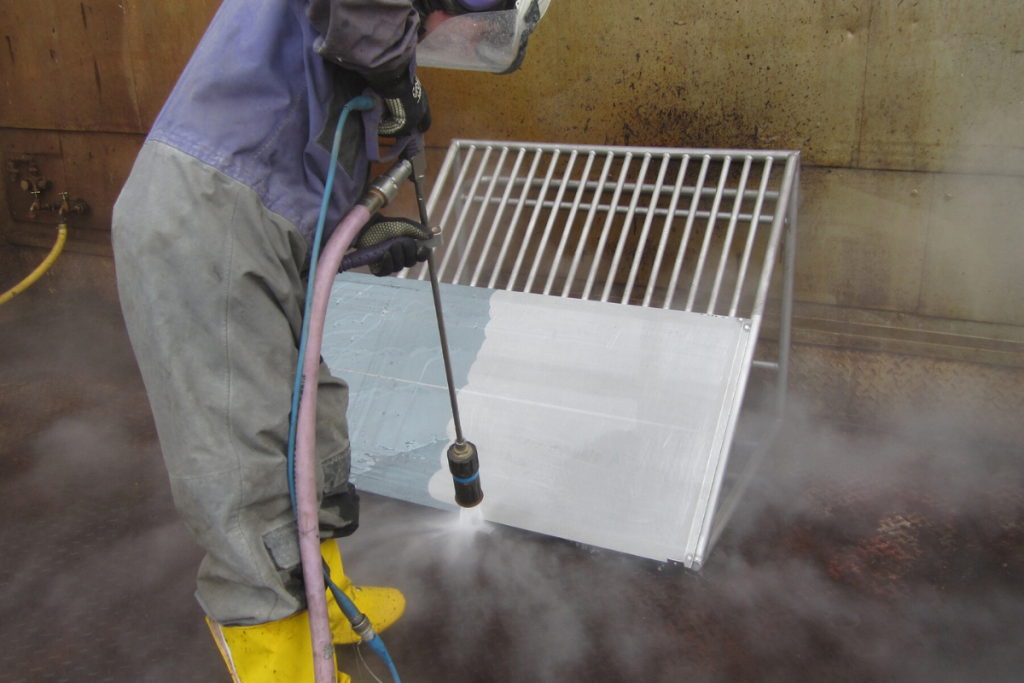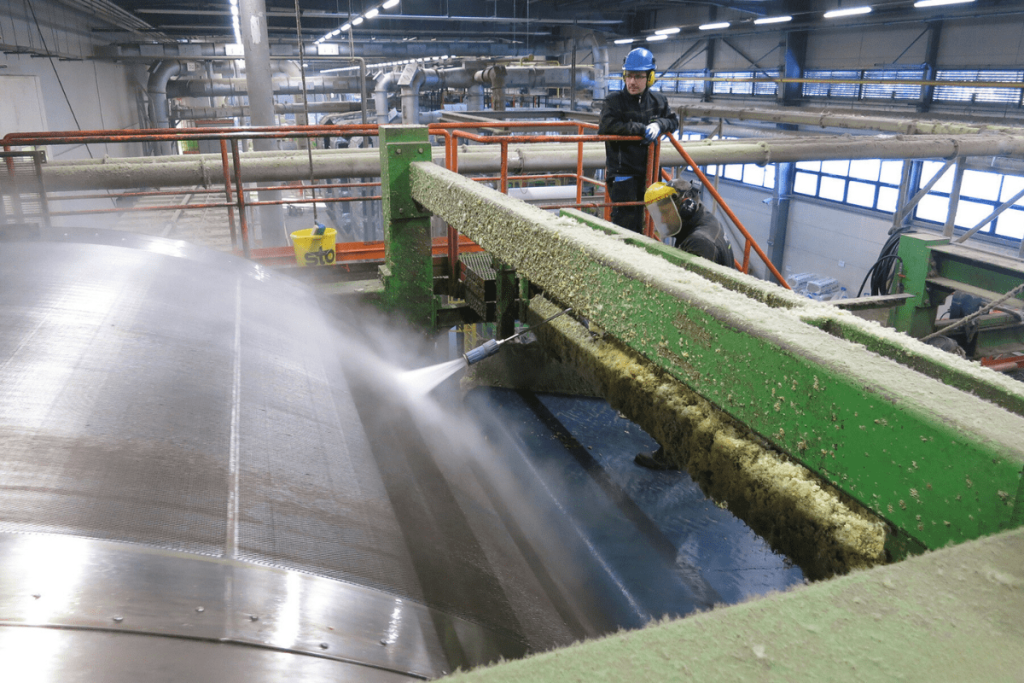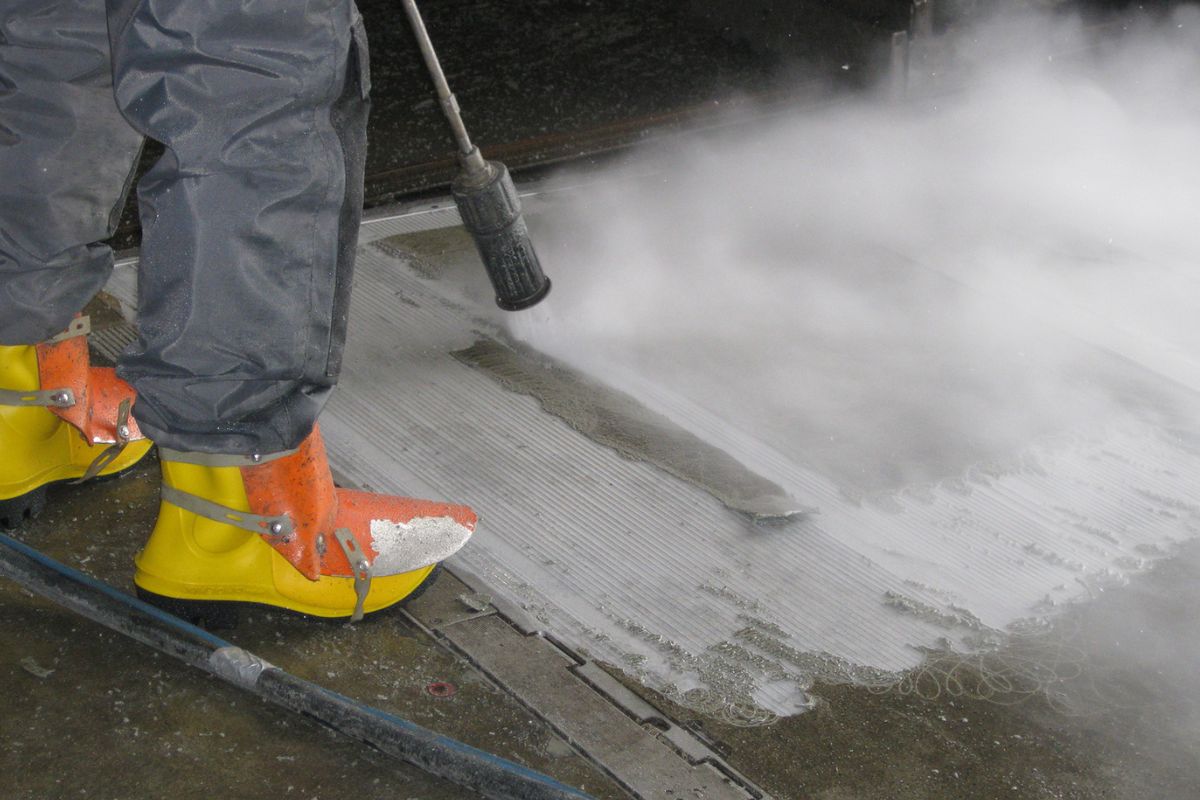There are many different methods in industry for cleaning and maintaining infrastructure. However, one of the most effective and versatile techniques is hydrojetting. In this article we will explain in which situations this method can be used.
What does the hydrojetting process look like?
Hydrojetting is an effective cleaning method that uses a stream of water under very high pressure to remove dirt, sediment and blockages from various surfaces or pipes. This process is widely used in industry, construction and infrastructure maintenance. Below we explain what a typical hydrojetting process looks like:
1. Preparation and inspection
The first step is to prepare the area or element for cleaning. The operator prepares specialized equipment, including devices generating a high-pressure water stream and specialized nozzles. An inspection may also be carried out before the process begins to assess the degree of contamination and identify areas requiring special cleaning.
2. Select pressure and temperature
Depending on the type of contamination and surface, the operator selects appropriate hydrojetting parameters, such as water pressure and temperature. In some cases, such as removing grease, hot water may be more effective.
3. Water jet application
The operator directs a nozzle with a high-pressure water stream onto the surface or duct to be cleaned.
4. Removing impurities and blockages
High-pressure water removes various types of contaminants, such as fats, stones, sediments, paints, corrosion, tar, and even difficult-to-remove blockages.
5. Rinsing and quality control
Once the hydrojetting process is complete, the surface or duct is thoroughly rinsed with water to remove any remaining dirt and cleaning agent residue. A quality check is then performed to ensure that cleaning has been performed as expected.
6. Documentation and reporting
In some cases, especially in industry, the hydrojetting process must be carefully documented. Therefore, reports are created that contain information about the cleaning performed, parameters, and any observations regarding the condition of the cable or surface.
Application of hydrojetting
1. Cleaning of building facades
Hydrojetting is used to remove dirt, algae, moss and dirt from building facades. A high-pressure water stream effectively cleans the surface, restoring its aesthetic appearance, but also prevents the degradation of the structure and extends its life.
2. Cleaning heat exchangers
Deposits such as scale, mineral deposits or chemical deposits that accumulate on the pipes and plates of heat exchangers can significantly reduce their efficiency. As a result, they prevent the device from working properly, leading to higher energy consumption and operating costs. Cleaning heat exchangers improves the efficiency of these devices. Removes accumulated impurities, restoring their original performance. Thanks to this, they work more efficiently. Additionally, clean heat exchangers are more durable, extending their life and reducing the need for frequent repairs or replacements. This is particularly important in the industrial and energy sectors, where the efficiency of heating systems is a priority.
3. Cleaning outside buildings, removing plaster from buildings
For exterior cleaning, hydrojetting can be used to remove plaster, paint, graffiti and other protective coatings. Cleaning with this method not only restores the original appearance of the facade, but also prepares the surface for possible conservation work, painting or applying new plaster. It is worth emphasizing that hydrojetting allows you to clean surfaces outside buildings without the need to use chemical cleaning agents, which translates into environmental protection. Moreover, this method ensures effectiveness in removing even the most difficult to remove substances, which is especially important in the case of graffiti or old, durable paints.
4. Cleaning steel surfaces and tanks
In industry, especially in the construction, petrochemical and energy sectors, steel surfaces are exposed to various types of contamination and corrosion. Mineral deposits, grease, paint, rust and other contaminants can accumulate on steel surfaces, leading to their degradation. Hydrojetting is used to remove these contaminants. A high-pressure water stream not only removes contaminants, but also reveals a clean surface of the steel, restoring its original appearance and durability.
In turn, industrial tanks such as tanks for chemical liquids, water, fuel and oils also require regular cleaning to prevent deposits from accumulating and reducing capacity. Hydrojetting allows for the effective removal of sediments, cleaning the inside of tanks and maintaining them in appropriate cleanliness and safety standards. In the case of tanks in which chemical substances are stored, hydrojetting cleaning prevents crystallization, hardening or oxidation of substances that could harm the structure of the tank.


5. Cleaning chimneys and chimney coolers
Cleaning chimneys and chimney coolers is an important process in the energy and chemical industries. Chimney coolers are responsible for heat dissipation and at the same time are susceptible to the accumulation of sediments and soot, which affects their efficiency. When stack coolers become dirty, their ability to cool effectively is limited, which can lead to excessive temperature increases and reduced production efficiency. In the case of chimneys, sediment and soot accumulated on the interior walls can pose a fire hazard. Hydrojetting is used to remove these contaminants. Thanks to intense pressure, water breaks down impurities and then rinses them away. This process restores the full efficiency of chimney coolers and minimizes the risk of fires in chimneys.
6. Removal of corrosion, paint, rubber and bitumen coatings
The use of hydrojetting to remove corrosion from metal surfaces is becoming more and more popular. Corroded surfaces, such as pipelines or steel structures, can be susceptible to damage and pose a threat to the durability of the structure. Water under high pressure is able to break the corrosion layer, revealing a clean metal surface. This restores durability and prevents further corrosion. Hydrojetting is also used in the process of removing paint coatings from various surfaces, for example in the case of renovation or renovation of buildings. Pressurized water effectively removes paint layers, restoring the original appearance of the surface. This is a much more ecological and precise method compared to traditional chemicals or sandblasting.
Additionally, in some industries, such as the petrochemical industry, rubber or bituminous coatings are often used to protect surfaces from destructive substances. However, over time these coatings can become damaged or contaminated. Hydrojetting is used to remove these substances, restoring the surface to its original condition.

7. Renovation of concrete surfaces
Concrete surfaces such as sidewalks, squares, bridges and parking lots are often subject to degradation due to exposure to weather conditions, mechanical wear and the accumulation of dirt. Hydrojetting is an effective and ecological method that allows you to restore the aesthetics and durability of concrete surfaces. The water stream thoroughly cleans the concrete, revealing its original appearance and color.
8. Unblocking pipelines and other pipe installations
Pipelines, both water supply, sewage and industrial, may become polluted, sedimented, clogged, and internally corroded over time, which can significantly restrict the flow of water or other substances. This often leads to drainage or delivery problems. Hydrojetting removes these obstacles, restoring full capacity to pipelines.
9. Exposing reinforcement in reinforced concrete structures
In the case of reinforced concrete structures, especially large-scale and older buildings, the exposure of reinforcement is a key stage in the process of diagnostics, renovation and modernization. This can be achieved using the hydrojetting method. Reinforcement, usually in the form of steel bars or mesh, plays a fundamental role in maintaining the structural integrity of a building. Thanks to a thorough assessment of the reinforcement, it is possible to determine the scope of repair work and plan modernization.
10. Removing mortar, lime or tar residues
In the case of construction, especially during renovation work, removing mortar or concrete residues may be necessary to restore the surface to its original condition or prepare it for further work. Hydrojetting is perfect for removing hard mortar residues from both vertical and horizontal surfaces. Precise adjustment of the water jet pressure allows only the surface layers to be removed, without damaging the substrate.
The same applies to lime, which, when used for various construction and renovation purposes, may leave residues on surfaces that are difficult to remove. Hydro jetting will also work well when removing tar from the surface of devices or installations.

11. Removing paint from asphalt
Removing paint from asphalt is often required during renovation work on roads, parking lots, airports and other surfaces. The paint can be difficult to remove using traditional methods. In this case, the hydrojetting method also proves to be effective, as it can precisely remove paint from the asphalt surface.
Summary
A hydrojetting service can make a significant contribution to preventing breakdowns, improving efficiency and maintaining the highest standards of cleanliness. Thanks to the ability to adjust water pressure to specific needs, hydrojetting is one of the most effective cleaning methods in the industrial industry. Therefore, if you are interested in using the service, please contact us. Our company has appropriate equipment and qualified operators who will be happy to perform such a service for you.

Photos falch.com

